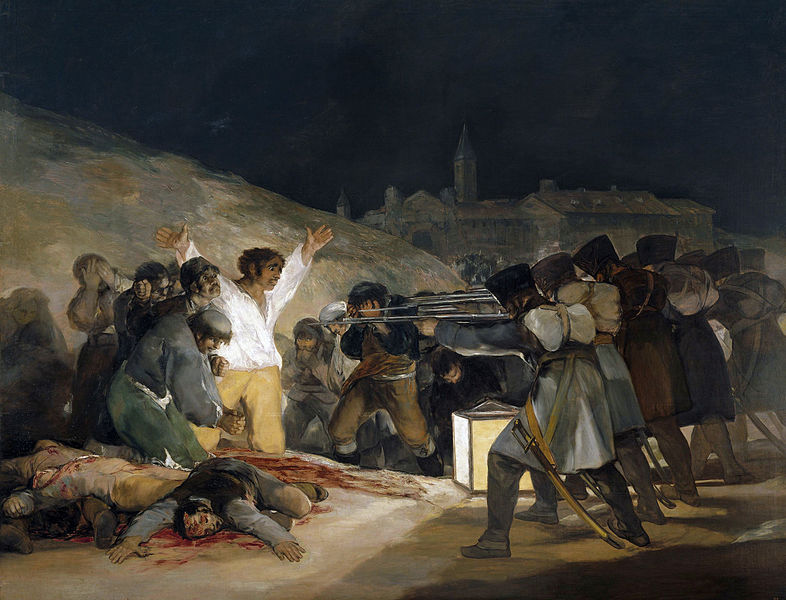Goya was born in a village in northern Spain in 1746, his family then moved to Saragossa. He went to Italy to study art, returning to Spain when thirty one years old where he married the daughter of a painter. He painted frescoes in the local cathedral and went on to paint designs for royal tapestries in Madrid in the rococo (ornate) style prevalent at the time. This was an important time in his development as an artist. He soon was to become influenced by neoclassicism and studied the paintings of Velasquez, this led him to use a more spontaneous painting technique. Soon he was asked to paint portraits of the Spanish aristocracy. Following a serious illness he became deaf when forty-six which had the effect of making him less sociable.
These were turbulent times in Spain, Napolean had invaded Spain, Madrid was occupied by the French and then between 1808 and 1814 there raged the Spanish War of Independence, the population rebelled against their occupiers, which is when this painting was commissioned. Goya was a Spanish liberal who disliked Charles IV’s authority and was at first not against the French, he in fact became the court painter for French royalty and took an oath of loyalty to Jospeh Bonaparte. He was forgiven by the French authorities. He expresses his horror of armed conflict in etchings and in a series of paintings, he experienced dark visions. One of his paintings, The Naked Maja landed him before the Spanish Inquisition. He went into voluntary exile in France in 1824 and died there in 1828 aged eighty two,
In this painting Goya has portrayed his impression of an historical event which took place in 1808 in Madrid, when the French retaliated against the Spanish rebels. He used oil on canvas to paint this dramatic scene that is so real and vivid. Kenneth Clark wrote ‘Goya was not simply a high speed camera,’ he drew from memory ‘it took shape in his minds eye as a pattern of lights and darks.’ This is a work of Goya’s imagination. The impression on viewing the scene is one of shock, the action takes place right in front of us, there is little space between us and the men. We see the background colour of the sky, using black, sombre greys and browns are used to paint the cathedral and other buildings, while the foreground is lit by a square lantern placed near the feet of the firing squad, this area is full of colour, light covers the figures on the left, creating a stark contrast. The colours here are glowing whites, gold and blood red. We see the terrified faces of the rebels, onlookers cover their eyes in horror, the faces of the soldiers, on the other hand, are hidden from us. The essence of the brutality of war is embedded in the whole work, Goya does not hold back from expressing his abhorrence. Shot men are sprawled on the ground, the man dressed in white and yellow looks at the firing squad, he is next, his eyes are wide open, arms raised in the air, he has no escape.
Fifty years later Edward Manet , who had seen this painting, painted The Execution of Emperor Maxilmillian in 1867, similar in composition, but perhaps without the same impact on the viewer.
Barry kindly suggested this painting.
Image courtesy of Wikipedia commons

